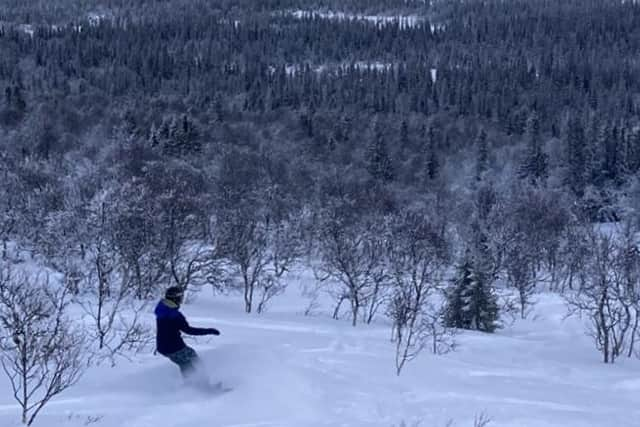Travel: Trillevallen, the Swedish ski resort that time forgot
The largest ski resort in Sweden is Åre, just over 50 miles west of Östersund in Jämtland County. Its highest point – the summit of Åreskutan – may only be 1,420m above sea level, but with a rambling 91km network of pistes and a town full of functional hotels and ski-themed bars, if you half-close your eyes it can sometimes feel as if you’re in one of the larger North American ski areas.
Sure, there are plenty of things that make Åre feel distinctively Swedish, from the beautiful century-old funicular that still rattles skiers half-way up the hill from the old town, to the herds of reindeer that sometimes wander beside its quieter slopes, to the mid -mountain Kastrullen waffle cabin, serving traditional Swedish waffles with cloudberry jam and whipped cream. To an extent, though, you have to seek these things out. If you spent all your time lapping the most easily-accessible runs directly above the town, you’d mostly find yourself encountering the kinds of 21st century infrastructure, 21st century crowds and 21st century lift-lines that wouldn’t look out of place in Utah or Colorado.
Advertisement
Hide AdAdvertisement
Hide AdNot that there's anything wrong with a ski resort being busy, of course – Åre has a lot going for it, so the crowds shouldn't come as a surprise. But you don't need to travel very far – less than 20 miles, in fact – to find yourself in a place which, from a snowsports perspective, feels like it exists in a completely different era.


First established in the 1930s, the pocket-sized resort of Trillevallen is an infinitely mellower proposition than its flashier neighbour up the road – a ski area that time forgot, but in the best possible way.
At its highest point, the whaleback-shaped mountain of Välliste on which it sits rises just 1,025m above sea level, making it feel somewhat Scottish in scale, and if you look north from its summit you can see the bulk of Åreskutan, seemingly enormous by comparison in the middle-distance. Skiers and boarders enjoying this view are unlikely to be feeling envious of those on the larger mountain, however – if anything, they'll probably be feeling quite smug.
Trillevallen’s many advantages are not immediately obvious – in fact, at first glance the piste map suggests it is a small resort with little to offer: one chairlift and six surface lifts serving just 22km of pistes, mostly reds, with a sprinkling of blacks near the summit of Välliste and some beginner-friendly blues and greens towards the bottom. Spend a little time exploring, though, and it soon becomes apparent that there’s a lot more to Trillevallen than you might think.
The first big thing in Trillevallen's favour is its orientation. Because the long whaleback of Välliste runs from south-west to north-east, and because the resort is situated on the mountain's south-east facing flank, the pistes are largely sheltered from the prevailing westerly and south-westerly winds. As a result, you're much more likely to find deep, soft powder snow here after a storm than you are in Åre, where almost all of the pistes face south-west, making them prone to scouring. Also, what Trillevallen lacks in altitude it more than makes up for in latitude; at a little over 60 degrees north, the winters here are properly cold, with temperatures generally ranging between -6C and -12C in January. Freeze-thaw cycles aren’t much of an issue. When we made a family trip here in mid-February, hoping for somewhere compact and child-friendly, we arrived to find half a foot of fresh snow and the temperature hovering around -15C. When I heaved our big, heavy bag of ski gear out of the sleeper train from Stockholm onto the deserted platform at Undersåker, the nearest stop to the resort (population 438), the snow on the ground was so light it exploded into the air as if I'd detonated a bomb inside a bag of feathers.
Of course, there's no point having great snow if the place you're skiing is so crowded that all the runs get tracked out by lunchtime. Happily, though, Trillevallen is mysteriously quiet. Not so quiet as to be sinister – the restaurant at the base station always felt good and busy, as did the beautiful old Trillevallens Hogfjallshotell where we stayed, recently renovated in a way that preserves its mid-20th century charm. Still, it was quiet enough that on our first day we managed to luck into an entirely untracked piste that nobody else seemed to be skiing, and so spent a glorious half an hour enjoying easy-angled powder laps before leaving to explore the rest of the hill.
When we finally managed to tear ourselves away from our secret piste, we quickly discovered Trillevallen's other big selling point: its trees. Mostly gnarled old silver birches with huge fronds of lichen hanging from their branches, rather than forming impenetrable barriers the trees here seem to space themselves out naturally, leaving gaps just big enough for a skier or boarder to weave through. Towards the north-eastern end of the ski area – the zone best-sheltered from the wind, and therefore holding the best snow – a long, winding red run called Kärringsvängen curves around the edge of a huge expanse of these trees, offering infinite possibilities. Packing a huge variety of terrain into a small area and also whisking guests back to a simpler, quieter time, Trillevallen might just be the closest thing the skiing world has to a Tardis.
